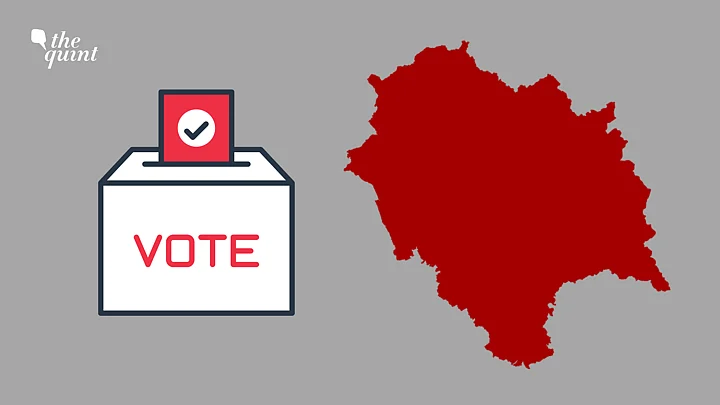Caste is a factor that permeates all electoral contests in India, it is constant in its influence from deserts to mountains.
The hilly state of Himachal Pradesh is set to vote in the Assembly election on 12 November. A total of 68 seats are up for the grabs, of which 17 are reserved for Scheduled Castes (SC) and three for Scheduled Tribes (ST).
Will caste be a factor affecting the electoral apple carts in Himachal?
Let us examine.
Caste Composition in Himachal
As we look into the role caste in the political arena of Himachal Pradesh, it is pertinent to understand the demography of the hilly state. According to the 2011 Census, the total population of Himachal Pradesh is less than 70 lakh.
The politics in Himachal Pradesh has always been dominated by Rajputs and Brahmins as the upper caste population is the highest in the state. According to the 2011 Census, around 51 percent of the population of the state comprises of upper castes, of which 33 percent are Rajput and 18 percent are Brahmin.
This data can be used to understand why five out of six chief ministers in Himachal Pradesh have been Rajputs. Among the other castes, SCs constitute 25 percent of the population, the share of ST communities is five percent, and OBCs around 13-14 percent, with the remaining five percent belonging to other castes and communities including Muslims and Sikhs.
As Rajputs and Brahmins dominate the political scene, both the BJP and the Congress have fielded 28 Rajput candidates each, while the latter has fielded more Brahmin candidates than the BJP. Twelve Brahmin candidates are in the fray from the Congress while nine are contesting from BJP.
Will Caste Matter?
Though there hasn't been caste violence in Himachal Pradesh and even the voting patterns do not show the influence of caste clearly, the fact is that all chief ministers in the state have been from upper castes.
Moreover, there are no prominent leaders from OBC, Dalits, or other historically subjugated castes in Himachal Pradesh unlike in Bihar or Uttar Pradesh.
Even though the reins of power in Himachal Pradesh are held by Rajputs and Brahmins, the 30 percent population of SC-ST communities holds the key to success. Lahaul Spiti district has the highest population of tribal communities at 81 percent, while Kinnaur has a 57 percent tribal population.
An estimated 30.34 percent population in Sirmaur district belongs to Scheduled Castes followed by 29 percent in Mandi, 28 percent in Solan and Kullu each, and 26 percent in the capital Shimla.
Both the Congress and the BJP are trying to woo the tribal and Dalit voters. A hint of their importance can be seen from the fact that the BJP had recently sent Dalit academician Dr Sikandar Kumar to Rajya Sabha from the state, and in 2020 the party had appointed Suresh Kashyap – a Dalit, as the state president. Kashyap is Lok Sabha MP from Shimla and had been MLA from the Pachhad Assembly segment twice.
Voting Patterns in the Past
In 2017, Rajputs voted en-masse for BJP. The party got 49 percent of the Rajput vote in 2017 while Congress could muster 36 percent, according to surveys.
On the reserved seats, the BJP had been comparatively more successful as it secured 13 out of 17 reserved seats in the state. But percentage-wise, the Congress got 48 percent votes from Dalits while the BJP was a tad behind at 47 percent.
Though the political power of OBCs in Himachal Pradesh is not much talked, about 13 percent votes are enough to turn turtle the results. There are 18 seats dominated by the OBCs in Himachal Pradesh of which nine are in the Kangra district.
In the last election, voters from OBC community polled in favour of the BJP which secured a 48 percent vote share of OBC votes while Congress managed to get 43 percent of the chunk. The other parties secured a 9 percent vote share from the OBC chunk.
Who Will the Hattis Support?
Before the announcement of elections in Himachal Pradesh, the Union government led by Prime Minister Narendra Modi played the ‘reservation card’ by announcing ST status for the Hatti community. This community had announced that they would boycott the election if they were not given the reservation as tribal.
The population of Hattis is around three lakh in the state, with persons from the community generally occupied in tending vegetable and grain crops, animal husbandry, sale of wool and meat products in the local community market.
Hattis are concentrated around Shillai, Paonta Sahib, Renukaji, and Pacchad Assembly segments but they can play a crucial role in at least in nine Assembly segments around Shimla and Sirmaur.
The SCs in the area are up in arms against the ST status granted to Hattis. The former contend that they would not be able to register cases of Dalit atrocities against Hattis due to their newly-awarded tribal status.
Thus, the BJP may be able to garner the support of Hattis with their recent move but they will also face the wrath of the Dalits.
